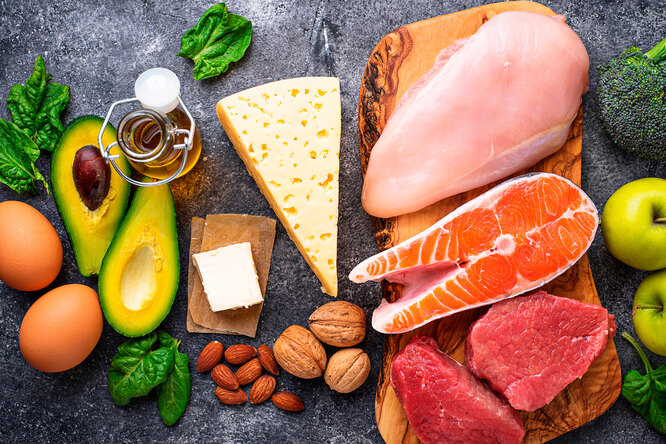Low-carb diet
Rice and the low-carb diet. Why is bun better? Drying.
High-carbohydrate diets are most commonly used for weight loss and are based on reducing the intake of foods with a high glycaemic index. There are various modifications of these diets, but the basic idea boils down to sharp carbohydrate restriction – up to 30% of the caloric content of the diet (up to 100 g); increasing the share of protein – 20-30%, and the basic energy intake is provided by fats – about 50-60% of daily calorages. The most striking example of a low-carbohydrate diet is the Atkins diet, in the first two weeks the carbohydrate intake is limited to 20 grams, subsequently to 50 grams.
In chronic carbohydrate-deficient foods, liver reserve glycogen is utilised to maintain normal glycaemic values. In the complete absence of carbohydrate intake its stores run out after 48 hours, accompanied by partial dehydration. Subsequently, fat oxidation is activated for gluconeogenesis; free fatty acids (FFAs) are metabolised by the liver and muscles to provide energy requirements, and their partial oxidation leads to the formation of ketone bodies (acetone, acetoacetate, |3-hydroxybutyrate), which can be used as fuel by all tissues containing mitochondria. When carbohydrate intake is severely restricted (less than 50 g per day), ketosis develops.
There are currently no studies on long-term (more than 12 months) low-carbohydrate diets. But according to the results of research studies lasting from six weeks to one year, following such diets for six months leads to a number of favorable changes in the body: reduction of body weight, triglycerides, pro-inflammatory blood markers; increase of low density lipoproteins (LDL), increase of high density lipoproteins (HDL).
Against the background of increased ketone bodies, appetite is inhibited, fasting and postprandial glycemia are significantly reduced due to reduced hepatic production of glucose and insulin levels. An additional factor that improves insulin action may be the elevated leucine levels seen in a low-carbohydrate diet with excessive protein intake. Taken together, these changes stimulate the formation of SLCs and glycerol from deposited triglycerides. But these changes have only been demonstrated in short-term studies. And when the weight loss effects of a low-carbohydrate and high-carbohydrate diet are compared over a one-year period, the weight loss is comparable.
However, a number of adverse effects of severe carbohydrate restriction have been reported, especially in studies lasting more than six months: decreased lean mass, lower blood levels of important micronutrients (potassium, calcium, magnesium and iron) and increased homocysteine, LDL cholesterol and SLC levels; increased urinary calcium excretion and nephrolithiasis risk. Excessive ingestion of SFCs in the liver, fat and muscle tissue over a long period of time leads to impaired insulin sensitivity at the receptor level. This is particularly characteristic of low-carbohydrate, high-fat diets.
Severe restriction of fruit and vegetables and frequent consumption of meat food increase the possibility of developing various neoplasias in patients following low-carbohydrate diets.
Arterial hypertension
Studies have shown that a low-carbohydrate diet is effective in reducing blood pressure levels and is preferable for hypertension.
Weight loss
Reducing carbohydrate intake is a much more effective method of weight loss than low-fat diets, concludes a large Harvard University study. An analysis of 53 studies of 67,000 diets found that those who went on low-fat diets for a year were about one kilogram heavier than those who used ‘low-carb’ diets.

